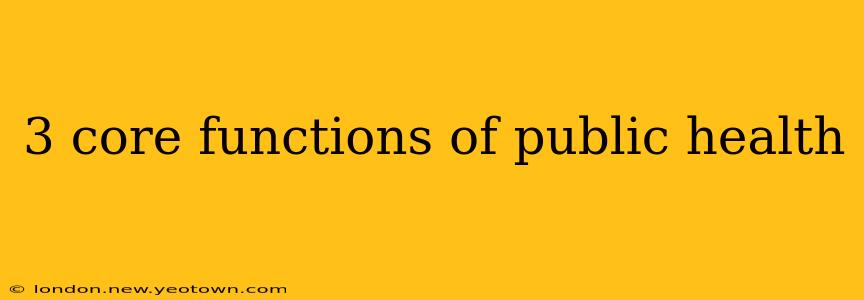The Three Core Functions of Public Health: A Story of Protecting Communities
Imagine a bustling city, teeming with life, energy, and… potential health crises. That's where public health steps in, not as a single superhero, but as a dedicated team working behind the scenes to keep the city thriving. Their work hinges on three core functions: assessment, policy development, and assurance. Let's unpack each one, exploring how they work together to create a healthier, safer community.
1. Assessment: Understanding the Landscape
Our story begins with a dedicated team of public health professionals. Think of them as skilled detectives, meticulously investigating the health of the city. This is the assessment function – the crucial first step in understanding the health needs of a population. They don't just react to crises; they actively seek out patterns, trends, and potential threats.
How do they do it? Through a variety of methods. Imagine them poring over data: analyzing disease statistics, studying birth and death rates, mapping out areas with high rates of chronic illnesses, or surveying residents about their health habits and concerns. They might interview people directly, collect samples for lab testing, or partner with local hospitals and clinics to get a complete picture.
This investigative work allows them to identify health disparities, pinpoint vulnerable populations, and understand the root causes of health problems. For instance, they might discover that a particular neighborhood has a disproportionately high rate of asthma, linked to poor air quality. This is crucial information, guiding the next stage of their work.
2. Policy Development: Shaping a Healthier Future
Armed with their assessment findings, our public health team now shifts to policy development. This isn't about imposing rules; it's about crafting evidence-based strategies to address the health challenges they've identified. They use their data to inform decisions, collaborate with community leaders, and advocate for changes that will improve the overall health of the city.
What might this look like? Perhaps they'll propose new regulations to improve air quality in the neighborhood with high asthma rates, advocating for stricter emissions standards for factories or encouraging the planting of more trees. Or maybe they'll launch public awareness campaigns to educate residents about asthma triggers and management techniques. They could also advocate for policies that increase access to affordable healthcare or healthy food options. The goal is always to create sustainable, long-term improvements.
Policy development is a collaborative effort, involving community members, policymakers, healthcare providers, and other stakeholders. It's about building consensus and ensuring that policies are both effective and equitable.
3. Assurance: Ensuring Access to Essential Services
The third core function, assurance, is where the rubber meets the road. This is about making sure that the city's residents have access to the services and resources they need to stay healthy. It's not enough to identify problems and develop policies; public health professionals must ensure that those policies are effectively implemented and that people can actually utilize the services.
How does this play out? It could involve ensuring a sufficient supply of vaccines, monitoring the quality of drinking water, enforcing food safety regulations, or coordinating emergency response systems. It might mean partnering with local organizations to provide health education programs, screening services, or support for people with chronic conditions. It’s about building a strong healthcare infrastructure and ensuring equitable access for all. It's about making sure that policies are not just on paper but are truly benefiting the population.
Frequently Asked Questions (FAQs)
What is the difference between public health and healthcare? Public health focuses on preventing disease and promoting health at the population level, while healthcare focuses on treating individuals who are already sick.
Who are the key players in public health? Public health professionals come from a variety of backgrounds including epidemiologists, health educators, environmental health specialists, and health policy analysts. They often work in collaboration with community leaders, healthcare providers, and policymakers.
How is public health funded? Funding for public health programs comes from a variety of sources, including government agencies, private foundations, and philanthropic organizations.
How does public health address health disparities? Public health uses data to identify health disparities and then develops targeted interventions and policies to address the root causes of these inequalities. This includes considering social determinants of health, such as access to resources and economic stability.
The three core functions—assessment, policy development, and assurance—are interconnected and essential for a healthy community. They are not merely steps in a linear process, but rather interwoven activities that constantly inform and reinforce one another, creating a powerful system for preventing disease, promoting health, and protecting the well-being of the population. It's a continuous cycle of learning, adapting, and working tirelessly to ensure a healthier future for all.

